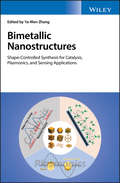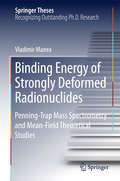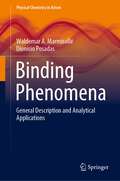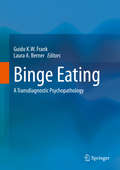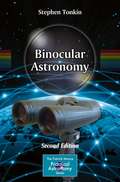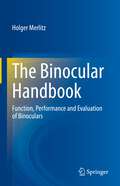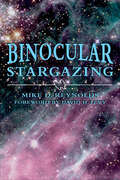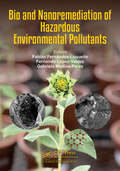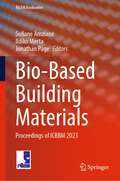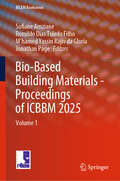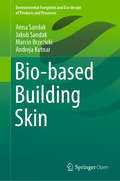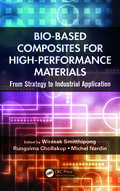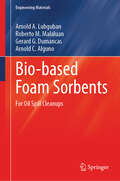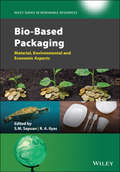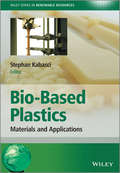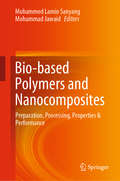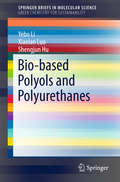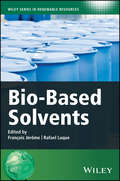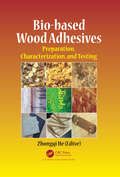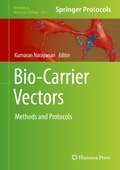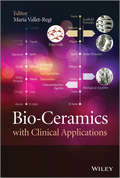- Table View
- List View
Bimetallic Nanostructures: Shape-Controlled Synthesis for Catalysis, Plasmonics, and Sensing Applications
by Ya-Wen ZhangSystematically summarizes the current status and recent advances in bimetallic structures, their shape-controlled synthesis, properties, and applications Intensive researches are currently being carried out on bimetallic nanostructures, focusing on a number of fundamental, physical, and chemical questions regarding their synthesis and properties. This book presents a systematic and comprehensive summary of the current status and recent advances in this field, supporting readers in the synthesis of model bimetallic nanoparticles, and the exploration and interpretation of their properties. Bimetallic Nanostructures: Shape-Controlled Synthesis for Catalysis, Plasmonics and Sensing Applications is divided into three parts. Part 1 introduces basic chemical and physical knowledge of bimetallic structures, including fundamentals, computational models, and in situ characterization techniques. Part 2 summarizes recent developments in synthetic methods, characterization, and properties of bimetallic structures from the perspective of morphology effect, including zero-dimensional nanomaterials, one-dimensional nanomaterials, and two-dimensional nanomaterials. Part 3 discusses applications in electrocatalysis, heterogeneous catalysis, plasmonics and sensing. Comprehensive reference for an important multidisciplinary research field Thoroughly summarizes the present state and latest developments in bimetallic structures Helps researchers find optimal synthetic methods and explore new phenomena in surface science and synthetic chemistry of bimetallic nanostructures Bimetallic Nanostructures: Shape-Controlled Synthesis for Catalysis, Plasmonics and Sensing Applications is an excellent source or reference for researchers and advanced students. Academic researchers in nanoscience, nanocatalysis, and surface plasmonics, and those working in industry in areas involving nanotechnology, catalysis and optoelectronics, will find this book of interest.
Bimodal Oxidation: Coupling of Heterogeneous and Homogeneous Reactions
by Robert BakhtchadjianThis book is devoted to the problems of oxidation chemical reactions and addresses bimodal reaction sequences. Chemical reactions of oxidation, occurring under certain conditions and in multicomponent systems are complex processes. The process of the oxidation essentially changes in the presence and contact of the solid substances with reactants. The role of solid substances and the appearance of this phenomenon in oxidation reaction are discussed. The reader will understand the "driving forces" of this phenomenon and apply it in practice. Written for chemists, physicists, biologists and engineers working in the domain of oxidation reactions. Key Selling Features: Covers the historical background, modern state of the art, and perspectives in investigations of the coupling between heterogeneous and homogeneous reactions Discusses the feasible pathways of the coupling of heterogeneous and homogeneous reactions in oxidation in man-made and natural chemical systems Addresses the abundance, peculiarities and mechanisms of the bimodal reaction sequences in oxidation with dioxygen in recent decades Discusses the existence of the bimodal reaction sequences in chemical systems investigations in atmospheric chemistry and heterogeneous photocatalysis Presented in a simple concise style, accessible for both specialists and non-specialists
Bin ich etwas Besonderes?: Was uns von den Tieren unterscheidet – und was nicht
by Adam RutherfordVor etwa 45.000 Jahren haben wir Menschen uns mit der Schaffung von Kultur, Werkzeugen, Symbolik und Kunst von unseren Vorfahren und Ursprüngen entfernt. Diese „kognitive Revolution“ gab uns das Gefühl, dass wir etwas Besonderes sind. Schriftsteller, Wissenschaftler, Philosophen und Religionen staunen seit Jahrtausenden über unsere Brillanz. Dennoch sind wir mit dem Rest der Natur durch Gene, Anatomie und Physiologie verbunden und in einer gemeinsamen Evolution verwurzelt. Alle Arten sind einzigartig, aber sind wir einzigartiger als andere Tiere? Diese Frage geht an die Wurzel dessen, was wir sind. Doch viele wissenschaftliche Erkenntnisse haben im Laufe der Zeit Zweifel an der Sonderstellung des Menschen aufkommen lassen. Dinge, die wir einst als einzigartig menschlich betrachtet haben, sind es nicht. Wir sind nicht die einzige Spezies, die z.B. Pläne für die Zukunft schmiedet, vergangene Entscheidungen bereut, um verlorene Leben trauert und Sex aus anderen Gründen als der Zeugung von Nachkommen hat.
Binding Energy of Strongly Deformed Radionuclides: Penning-Trap Mass Spectrometry and Mean-Field Theoretical Studies (Springer Theses)
by Vladimir ManeaThis thesis reports results of precision mass spectrometry of exotic nuclides as a means of elucidating their structure. The work was performed with the ISOLTRAP spectrometer at CERN's ISOLDE facility. The author furthermore offers an overview of existing techniques used in Penning-trap mass spectrometry and also reports on recent promising developments regarding ISOLTRAP. This eloquently written treatment covers both theory and experiment, and includes a general phenomenological introduction to the nuclear-structure intuition contained in the trends of nuclear binding energies.
Binding Phenomena: General Description and Analytical Applications (Physical Chemistry in Action)
by Waldemar A. Marmisollé Dionisio PosadasThis book presents a unified description of binding equilibrium for a wide variety of systems focusing on acid-base and coordination chemistry, adsorption at interfaces, and electron binding in electrochemistry. It overviews more complex phenomena such as competitive binding to different sites and of different ligands. Multiple sites such as those occurring in macromolecules, colloidal oxides, humid substances, and proteins are briefly discussed and many experimental results for these types of systems are analyzed. Titrations and consideration of the distribution of binding constants are also presented. The book is mainly directed at undergraduate/graduate students of chemistry, biology, and earth sciences. It is supplementary to the standard physical and analytical chemistry courses and will help both students and teachers get a more in-depth knowledge and understanding of the systems analyzed.
Binge Eating: A Transdiagnostic Psychopathology
by Guido K. W. Frank Laura A. BernerThis book provides a comprehensive overview of our current understanding of binge eating, which is characterized by the uncontrollable consumption of large amounts of food in a discrete time period. Written by experts on eating disorders, it first introduces the phenotype of binge eating, including its epidemiology and assessment. It then describes the underlying neurobiological alterations, drawing on cutting-edge animal models and human studies to do so. In addition, it extensively discusses current treatment models, including medication, psychotherapy, self-interventions and disease prevention. Lastly, an outlook on the future research agenda rounds out the coverage. Given binge eating’s current status as an under-researched symptom, but one shared across many eating disorders, this book provides an up-to-date, integrative and comprehensive synthesis of recent research and offers a valuable reference for scientists and clinicians alike.
Binocular Astronomy (The Patrick Moore Practical Astronomy Series)
by Stephen TonkinBinoculars have, for many, long been regarded as an "entry level" observational tool, and relatively few have used them as a serious observing instrument. This is changing! Many people appreciate the relative comfort of two-eyed observing, but those who use binoculars come to realize that they offer more than comfort. The view of the stars is more aesthetically pleasing and therefore binocular observers tend to observe more frequently and for longer periods. "Binocular Astronomy", 2nd edition, extends its coverage of small and medium binoculars to large and giant (i.e., up to 300mm aperture) binoculars and also binoviewers, which brings the work into the realm of serious observing instruments. Additionally, it goes far deeper into the varying optical characteristics of binoculars, giving newcomers and advanced astronomers the information needed to make informed choices on purchasing a pair. It also covers relevant aspects of the physiology of binocular (as in "both eyes") observation. The first edition of this title was praised for its suggested objects for observation and especially for the finder charts for each object. In this second edition, this section is expanded in three ways. There are new objects, with more information on each object, and a re-organization of the objects for binoculars for easier selection for readers. "Binocular Astronomy" 2nd Edition puts an emphasis on understanding binoculars and their use. The additional content in this second edition reflects the latest developments in technology, available testing techniques, and practical ideas for binocular use. It also responds to the substantially positive reviews of the first edition, and is now even better suited to its target readership.
The Binocular Handbook: Function, Performance and Evaluation of Binoculars
by Holger MerlitzThis book is a comprehensive technical treatise on binoculars as visual optical instruments. The author begins by discussing the function of binoculars and the properties of human visual perception. Theoretical models for the synthesis of binoculars and the complex interplay of the different components of binoculars are described. Subsequently, the performance limits, as experienced by the observer in a variety of external conditions, are derived. In the concluding section, the book takes the reader outdoors, where they learn to evaluate the properties and limitations of their binoculars in the field, and to recognize possible problems that may be due to manufacturing errors or accidental damages. Thus, a level of knowledge is provided that will enable the reader to fully exploit the capacities of their binoculars. This book is written for those who work professionally with binoculars and are technically interested, but it is equally useful for professional staff working in the optical industry and the distribution of optical instruments. It includes recent discoveries and is easily accessible to anyone who is seriously interested in learning about binocular function. High school level math is useful to understand the derivations, but not needed to comprehend the results, which are discussed and displayed graphically.
Binocular Stargazing
by Mike D ReynoldsA guide to viewing stars, the moon, planets, meteors, comets, and more through binoculars. Many stargazers assume they must invest hundreds or even thousands of dollars in equipment before they can enjoy the wonders of the night sky. The truth is, though, that all you need is a simple pair of binoculars. This handy guide explains how to choose binoculars. This handy guide explains how to choose binoculars and use them to observe everything from comets to solar eclipses. Ideal for amateur astronomers of all ages, Binocular Stargazing is the perfect way to see the night sky through new eyes. Information on current binocular brands and models Extensive catalog of celestial objects Lists of what to look for in each season Instructions for safely viewing eclipses Tips on recording your observations
BIO 160 Laboratory Manual: Introduction to Human Anatomy and Physiology
by Chris SullivanLaboratory manual for exercises in basic life sciences and anatomy.
Bio and Nanoremediation of Hazardous Environmental Pollutants
by Fabián Fernando GabrielaThis book is a compendium of knowledge about nanomaterials and strategies for bioremediation over hazardous environmental pollutants. The book is divided into 2 sections. Section 1 deals with the polluted environment, where it explains that soil is in serious danger and highlights the primary hazardous pollutants. Besides, this section covers algae, autochthonous, introduced, or genetically modified organisms that are used to degrade hazardous contaminants. In Section 2, Bio- and Nanoremediation are shown through synthesis, green synthesis and molecular farming, and their applications or impacts. Moreover, this discusses bio- and nano-remediation, working together for better performance, organisms, and nanomaterials for environmental remediation.
Bio-Based Building Materials: Proceedings of ICBBM 2023 (RILEM Bookseries #45)
by Sofiane Amziane Ildiko Merta Jonathan PageThis book gathers peer-reviewed contributions presented at the 5th International Conference on Bio-Based Building Materials (ICBBM), held in Vienna, Austria, on June 21-23, 2023. Focusing on bio-based building materials (3BM) as well as their applications in sustainable building constructions, the contributions highlight the latest findings in this fast-growing field, addressing topics such as natural fibres- and aggregates, ramped earth, innovative hybrid composites based on bio-based ingredients, novel sustainable binders, energy efficiency aspects- and life cycle analysis of these materials.
Bio-Based Building Materials - Proceedings of ICBBM 2025: Volume 1 (RILEM Bookseries #60)
by Jonathan Page Sofiane Amziane Romildo Dias Toledo Filho M'hamed Yassin Rajiv da GloriaThis book gathers peer-reviewed contributions presented at the 6th International Conference on Bio-Based Building Materials (ICBBM), held in Rio de Janeiro, Brazil on June 17-20, 2025. Focusing on bio-based building materials (3BM) as well as their applications in sustainable building constructions, the contributions highlight the latest findings in this fast-growing field, addressing topics such as natural fibres- and aggregates, ramped earth, innovative hybrid composites based on bio-based ingredients, novel sustainable binders, energy efficiency aspects- and life cycle analysis of these materials.
Bio-based Building Skin (Environmental Footprints and Eco-design of Products and Processes)
by Anna Sandak Jakub Sandak Marcin Brzezicki Andreja KutnarThis book provides a compendium of material properties, demonstrates several successful examples of bio-based materials’ application in building facades, and offers ideas for new designs and novel solutions. It features a state-of-the-art review, addresses the latest trends in material selection, assembling systems, and innovative functions of facades in detail. Selected case studies on buildings from diverse locations are subsequently presented to demonstrate the successful implementation of various biomaterial solutions, which defines unique architectural styles and building functions. The structures, morphologies and aesthetic impressions related to bio-based building facades are discussed from the perspective of art and innovation; essential factors influencing the performance of materials with respect to functionality and safety are also presented. Special emphasis is placed on assessing the performance of a given facade throughout the service life of a building, and after its end. The book not only provides an excellent source of technical and scientific information, but also contributes to public awareness by demonstrating the benefits to be gained from the proper use of bio-based materials in facades. As such, it will appeal to a broad audience including architects, engineers, designers and building contractors.
Bio-Based Composites for High-Performance Materials: From Strategy to Industrial Application
by Wirasak Smitthipong Rungsima Chollakup Michel NardinSince synthetic plastics derived from fossil resources are mostly non-biodegradable, many academic and industrial researchers have shifted their attention toward bio-based materials, which are more eco-friendly.Bio-Based Composites for High-Performance Materials: From Strategy to Industrial Application provides an overview of the state-of-art in bi
Bio-based Foam Sorbents: For Oil Spill Cleanups (Engineering Materials)
by Arnold A. Lubguban Roberto M. Malaluan Gerard G. Dumancas Arnold C. AlgunoThis book highlights the advantages of using sorbents in oil spill cleanup while dealing with the challenges of limited capacity and disposal. Bio-based foam sorbents are new but promising sorbents to oil spill cleanup. They are environmentally friendly materials derived from renewable resources such as vegetable oil and biomass, designed to absorb or adsorb oil and other pollutants from water, coastal areas, wetlands, ice-covered waters, and urban surfaces. These foams offer a sustainable alternative to traditional petroleum-based sorbents, with comparable or even superior performance in oil adsorption capacity, recyclability, and biodegradability. Moreover, a bio-based foam sorbent with inherent hydrophobic property is discussed, opening a new pathway for bio-based foam sorbents that usually need surface modification. This book is a good read for environmental scientists, engineers, sustainability experts, and researchers offering insights in related to the chemistry, performance, and commercialization potential of bio-based foam sorbents. It explores various methods for synthesizing bio-based foam sorbents, providing a detailed examination of the underlying chemistry involved in these processes.
Bio-Based Packaging: Material, Environmental and Economic Aspects (Wiley Series in Renewable Resource)
by Christian V. StevensAn authoritative and up-to-date review of sustainable packaging development and applications Biobased Packaging explores using renewable and biodegradable materials as sustainable alternatives to non-renewable, petroleum-based packaging. This comprehensive volume surveys the properties of biopolymers, the environmental and economic impact of bio-based packaging, and new and emerging technologies that are increasing the number of potential applications of green materials in the packaging industry. Contributions address the advantages and challenges of bio-based packaging, discuss new materials to be used for food packaging, and highlight cutting-edge research on polymers such as starch, protein, polylactic acid (PLA), pectin, nanocellulose, and their nanocomposites. In-depth yet accessible chapters provide balanced coverage of a broad range of practical topics, including life cycle assessment (LCA) of bio-based packaging products, consumer perceptions and preferences, supply chains, business strategies and markets in biodegradable food packaging, manufacturing of bio-based packaging materials, and regulations for food packaging materials. Detailed discussions provide valuable insight into the opportunities for biopolymers in end-use sectors, the barriers to biopolymer-based concepts in the packaging market, recent advances made in the field of biopolymeric composite materials, the future of bio-plastics in commercial food packaging, and more. This book: Provides deep coverage of the bio-based packaging development, characterization, regulations, and environmental and socioeconomic impact Contains real-world case studies of bio-based packaging applications Includes an overview of recent advances and emerging aspects of nanotechnology for development of sustainable composites for packaging Discusses renewable sources for packaging material and the reuse and recycling of biobased packaging products Biobased Packaging: Material, Environmental and Economic Aspects is essential reading for academics, researchers, and industry professionals working in packaging materials, renewable resources, sustainability, polymerization technology, food technology, material engineering, and related fields.
Bio-Based Plastics
by Christian Stevens Stephan KabasciThe field of bio-based plastics has developed significantly in the last 10 years and there is increasing pressure on industries to shift existing materials production from petrochemicals to renewables.Bio-based Plastics presents an up-to-date overview of the basic and applied aspects of bioplastics, focusing primarily on thermoplastic polymers for material use. Emphasizing materials currently in use or with significant potential for future applications, this book looks at the most important biopolymer classes such as polysaccharides, lignin, proteins and polyhydroxyalkanoates as raw materials for bio-based plastics, as well as materials derived from bio-based monomers like lipids, poly(lactic acid), polyesters, polyamides and polyolefines. Detailed consideration is also given to the market and availability of renewable raw materials, the importance of bio-based content and the aspect of biodegradability.Topics covered include:StarchCellulose and cellulose acetateMaterials based on chitin and chitosanLignin matrix composites from natural resourcesPolyhydroxyalkanoatesPoly(lactic acid)Polyesters, Polyamides and Polyolefins from biomass derived monomersProtein-based plasticsBio-based Plastics is a valuable resource for academic and industrial researchers who are interested in new materials, renewable resources, sustainability and polymerization technology. It will also prove useful for advanced students interested in the development of bio-based products and materials, green and sustainable chemistry, polymer chemistry and materials science.For more information on the Wiley Series in Renewable Resources, visit www.wiley.com/go/rrs
Bio-based Polymers and Nanocomposites: Preparation, Processing, Properties & Performance
by Muhammed Lamin Sanyang Mohammad Jawaid<p>This book highlights the various types of polymer and nanocomposites that can be derived from biorenewable resources. It covers various aspects of biobased polymers and nanocomposites, including preparation, processing, properties, and performance, and the latest advances in these materials. <p>It also includes recent findings from leading researchers in academia and industry, government, and private research laboratories around the globe, providing the latest information on biobased polymers and nanocomposites. Offering an overview of the entire production process, it guides readers through all stages, from the raw source materials, processing and property characterization to application performance. <p>This book is suitable for professionals and researchers seeking in-depth practical information as well as the fundamental science behind this. It also serves as a point of reference for undergraduate and graduate students, as well as postdoctoral researchers working in the area of polymer and composites with a special emphasis on biobased materials.</p>
Bio-based Polyols and Polyurethanes (SpringerBriefs in Molecular Science)
by Yebo Li Xiaolan Luo Shengjun HuThis brief outlines the most recent advances in the production of polyols and polyurethanes from renewable resources, mainly vegetable oils, lignocellulosic biomass, starch, and protein. The typical processes for the production of polyols from each of the above mentioned feedstocks are introduced and the properties of the resultant polyols and polyurethanes are also discussed.
Bio-Based Solvents
by François Jérôme Rafael LuqueA multidisciplinary overview of bio-derived solvent applications, life cycle analysis, and strategies required for industrial commercialization This book provides the first and only comprehensive review of the state-of-the-science in bio-derived solvents. Drawing on their own pioneering work in the field, as well as an exhaustive survey of the world literature on the subject, the authors cover all the bases—from bio-derived solvent applications to life cycle analysis to strategies for industrial commercialization—for researchers and professional chemists working across a range of industries. In the increasingly critical area of sustainable chemistry, the search for new and better green solvents has become a top priority. Thanks to their renewability, biodegradability and low toxicity, as well as their potential to promote advantageous organic reactions, green solvents offer the promise of significantly reducing the pernicious effects of chemical processes on human health and the environment. Following an overview of the current solvents markets and the challenges and opportunities presented by bio-derived solvents, a series of dedicated chapters cover all significant classes of solvent arranged by origin and/or chemical structure. Throughout, real-world examples are used to help demonstrate the various advantages, drawbacks, and limitations of each class of solvent. Topics covered include: The commercial potential of various renewably sourced solvents, such as glycerol The various advantages and disadvantages of bio-derived versus petroleum-based solvents Renewably-sourced and waste-derived solvents in the design of eco-efficient processes Life cycle assessment and predictive methods for bio-based solvents Industrial and commercial viability of bio-based solvents now and in the years ahead Potential and limitations of methodologies involving bio-derived solvents New developments and emerging trends in the field and the shape of things to come Considering the vast potential for new and better products suggested by recent developments in this exciting field, Bio-Based Solvents will be a welcome resource among students and researchers in catalysis, organic synthesis, electrochemistry, and pharmaceuticals, as well as industrial chemists involved in manufacturing processes and formulation, and policy makers.
Bio-based Superabsorbents: Recent Trends, Types, Applications and Recycling (Engineering Materials)
by Sukanya Pradhan Smita MohantyThis book examines the synthetic approaches, properties, applications, and recyclability of bio-based superabsorbent polymers (SAP) in depth. It describes and compares bio-based SAPs with petro-based SAPs. Additionally, it explores the structure–property relationships of bio-based SAPs derived from various natural sources. The book covers current and emerging applications in health and hygiene products, agriculture, construction, and other areas. It also explores the recycling and reusing methods available for water recovery, pressure sensitive adhesives, etc. It discusses the issues behind the sharp increase in research attention, namely the prevailing research hotspots/clusters and suggestions with regard to present studies, works that have been significant and pivotal in the development of SAP research, and the current advances and future directions of research. It also presents the emerging applications of superabsorbent polymers.
Bio-based Wood Adhesives: Preparation, Characterization, and Testing
by Zhongqi HeAdhesive bonding plays an increasing role in the forest product industry and is a key factor for efficiently utilizing timber and other lignocellulosic resources. As synthetic wood adhesives are mostly derived from depleting petrochemical resources and have caused increasing environmental concern, natural product and byproduct-derived adhesives have attracted much attention in the last decades. Although adhesives made from plant and animal sources have been in existence since ancient times, increased knowledge of their chemistry and improved technical formulation of their preparation are still needed to promote their broader industrial applications. The primary goals of this book are to (1) synthesize the fundamental knowledge and latest research on bio-based adhesives from a remarkable range of natural products and byproducts, (2) identify need areas and provide directions of future bio-based adhesive research, and (3) help integrating research findings in practical adhesive application for maximal benefits. This book covers information on a variety of natural products and byproducts and the latest research on formulation, testing and improvement of the relevant adhesives in fifteen chapters written by an international group of accomplished contributors. This book will serve as a valuable reference source for university faculty, graduate students, research scientists, agricultural and wood engineers, international organization advocators and government agency regulators who work and deal with enhanced utilization of agricultural and forest products and byproducts.
Bio-Carrier Vectors: Methods and Protocols (Methods in Molecular Biology #2211)
by Kumaran NarayananThis detailed book explores techniques used in research efforts to adopt and combine the best capabilities from natural and artificial vector systems to assemble improved delivery technologies aimed for specific applications. The collection discusses vectors other than the traditional viral and non-viral systems and explores ideas for blending the best features of bacteria, nanoparticles, peptides, and hybrid systems for the delivery of biomaterials into cells, as well as a chapter on the application of shotgun proteomics and mass spectrometry as a tool to analyze the proteomic profile changes in cells that result from these interventions. Written in the highly successful Methods in Molecular Biology format, chapters include introductions to their respective topics, lists of the necessary materials and reagents, step-by-step, readily reproducible laboratory protocols, and tips on troubleshooting and avoiding known pitfalls. Authoritative and practical, Bio-Carrier Vectors: Methods and Protocols serves as an ideal guide for researchers working toward harnessing the power of multiple vectors in gene and drug delivery.
Bio-Ceramics with Clinical Applications
by Maria Vallet-RegiThis publication offers a unique approach that links the materials science of bioceramics to clinical needs and applications.Providing a structured account of this highly active area of research, the book reviews the clinical applications in bone tissue engineering, bone regeneration, joint replacement, drug-delivery systems and biomimetism, this book is an ideal resource for materials scientists and engineers, as well as for clinicians.From the contents:Part I Introduction1. Bioceramics2. BiomimeticsPart II Materials3. Calcium Phosphate Bioceramics4. Silica-based Ceramics: Glasses5. Silica-based Ceramics: Mesoporous Silica6. Alumina, Zirconia, and Other Non-oxide Inert Bioceramics7. Carbon-based Materials in BiomedicinePart III Material Shaping8. Cements9. Bioceramic Coatings for Medical Implants10. Scaffold DesigningPart IV Research on Future Ceramics11. Bone Biology and Regeneration12. Ceramics for Drug Delivery13. Ceramics for Gene Transfection14. Ceramic Nanoparticles for Cancer Treatment
